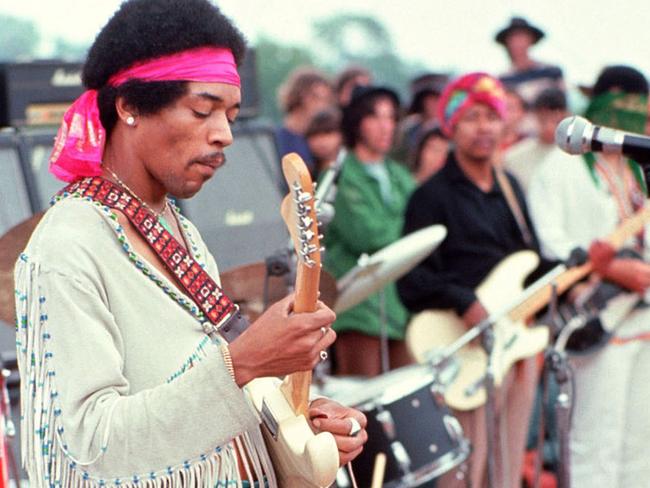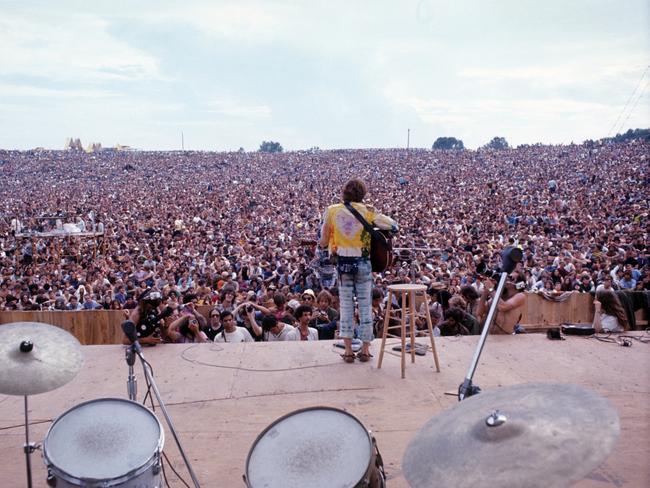What you didn’t know about Woodstock
THERE has never been a bigger, more amazing festival than the original Woodstock. The man behind it all reveals to news.com.au how it happened.
FORTY-EIGHT years ago a war was raging in Vietnam, Nixon was in power, Neil Armstrong had just landed on the moon, and outside a little town called Bethel in Upstate New York, a festival like no other had just wrapped up: Woodstock.
It was 1969 and an estimated 400,000 young Baby Boomers, had all just spent the weekend rocking out to the biggest names in rock and roll history: Jimi Hendrix, Janis Joplin, Crosby Stills Nash & Young, The Who, Santana and The Grateful Dead.
Merely weeks after the event, Time Magazine called it “history’s biggest happening”, both Jimi and Janis would be dead the following year, Joni Mitchell would be inspired to write the song Woodstock, and Warner Bro’s would have a total hit documentary on their hands, Woodstock: 3 Days of Peace & Music.
It was pretty clear that Woodstock had found its place in history’s hall of fame.
Behind this colossal moment in human history was one young man in particular — the son of a cop from Brooklyn, Artie Kornfeld. Regularly referred to as ‘The Father of Woodstock,’ without his music connections, Woodstock would never have happened.
At 74, Kornfeld’s resumé reads like a who’s who of rock and roll. Signing his first record deal at 16, by the time he was 24 he had written 52 songs that made it into the Billboard charts (five of which became number one hits), and had participated in more than 100 albums.
He’d travelled across America with Sonny & Cher in 1965 for their infamous ‘I Got You Babe’ tour and he counted The Beatles, Buddy Miles, Jimi Hendrix and the full Woodstock line-up as his friends, many of which he’d either signed or produced. Not only that but he was vice-president of Capitol Records, the youngest person ever to hold the position. His career was skyrocketing, yet Kornfeld was itching to do something that would go on to inspire a social movement.

“I was living in Manhattan in Sutton Place in those days in the Plaza 400. I wasn’t a hippie — I was a musician, songwriter, and producer. I was the only partner that didn’t do Woodstock for money because I could have been the president of Capitol by the time I was 25 — I had three more years on my contract and I quit to go into Woodstock Ventures.
“I had lost six friends who I played football with in high school who all died in Vietnam so I guess the war was playing on my mind,” Kornfeld told news.com.au.
Sitting around a kitchen table in the mid 1960s, while smoking joints with his late wife Linda and good friend Michael Lang, the idea for Woodstock was born. Kornfeld had the music connections, and Lang had produced just one music festival previously in California. Bringing on two more investors, they were soon planning a ticketed outdoor event for 25,000 people near a town called Woodstock. Little did they know that it would become one of the most famous events of the 20th century with close to half a million people, that they’d have to scrap admission and that it would take them well over a decade to make back the money they’d spend. But to Kornfeld this was all part of the magic of what made it so special.
“Woodstock was a miracle. If it didn’t rain, and if Michael had got the fences up, Woodstock wouldn’t have been what it was,” says Kornfeld.

Just 24 days out from the festival, Kornfeld was eager to document what he knew would become a monumental moment in rock and roll history. Kornfeld approached Freddy Weintraub who had just started working at Warner Bros., but a documentary about a bunch of hippies wasn’t an easy sell.
At the time, Warner Bros. was in trouble and documentaries weren’t doing well. Eventually Kornfeld had to speculate about the possibility of a tragedy occurring and that if Warner Bros. had it on film, it would be worth a lot of money.
“What if the towers that hold the lights and the sounds fall down and 200 kids get killed? Then you’ll have a disaster movie just like the Titanic,” is what Kornfeld said to Weintraub.
Thankfully that didn’t happen, but it was enough to convince Weintraub to hand over $100,000 so Kornfeld could make his movie with director Michael Wadleigh. They also brought on another young man to film who was a recent graduate from NYU with very few credits to his name; his name was Martin Scorsese.
One year later, the documentary would win an Academy Award and become one of the highest grossing films of its era. Yet the deal Kornfeld struck with Warner Bros. meant he had very little financial control and he would eventually walk away from the film, forgoing the opportunity to make about $US25 million ($A31.5 million).
“I didn’t want to ruin what Woodstock stood for with a big battle over money. I wanted people to remember Woodstock as what it was: a celebration of caring for each other.
“A socialistic, democratic thing happened at Woodstock which means when people didn’t have anything, others shared with everybody else. The fact is there was almost no violence among some 400,000 people,” says Kornfeld.

Despite his new-found success with Woodstock, Kornfeld struggled with coming down after the event, developing a cocaine addiction that would plague him for more than a decade. In the early 1980s he lost his first wife to a brain aneurysm and sixty days into his sobriety, his daughter, 16, died of a cocaine overdose. He’s since been sober for 36 years and is the founder of Cocaine Anonymous, a support group for those struggling with cocaine abuse.
“I lost a child and I lost a wife so I know what sorrow is. I try to bring elements of joy in these times to people that are hurting,” says Kornfeld.
During the 1980s, Kornfeld produced some of the biggest hits of the decade including Eye of The Tiger, Tracy Chapman’s Fast Car and Neil Young’s Rockin In The Free World. Kornfeld recounts what Young said when he reached out for his expertise.
“Artie you know what, I’ve done 14 albums but I’ve never had a gold or platinum album and you seem to know how to do that,” said Young to Kornfeld.
In recent years, Kornfeld has turned his focus towards speaking at schools and colleges to keep the spirit of Woodstock strong. Speaking to news.com.au, Kornfeld reflected on the current state of politics.
“People are not peaceful right now. With Woodstock we had the war in Vietnam, and I guess if our current president keeps going, maybe we’ll have a war. But maybe the millennials will pick things up and maybe there will be another Woodstock.”
With the current political climate drawing some stark similarities to Nixon’s America in 1969 and the hugely unpopular Vietnam War, it’s not hard to see why he’s so eager to remind today’s youth of Woodstock’s message before it’s too late.



